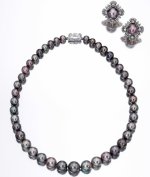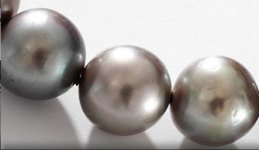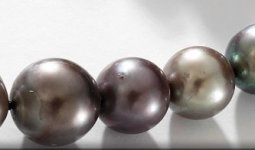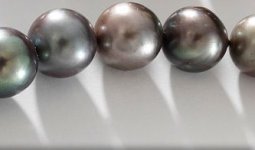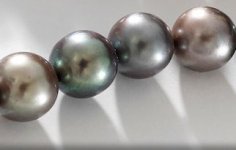I've posted this screen shot from Sotheby's for comment.
EDIT: Apparently not. The only allowed images are 620x280 and 19.5k That's not even email quality and I've always posted high definition images, so I'll assume it's a bug?
Instead, follow
this link and observe the image at the top of the page
Most of the images I've seen of this strand are from a distance, enhanced or manipulated. However, the individual surfaces of several parts are quite visible in this capture. (Good on Sotheby's for showing them as they really are.)
Although the origin of these pearls is not in question, in the differential diagnosis each scored high. Eight of ten points. A near perfect assessment because 1.5 points (x-ray and biopsy, .5 for scale) are not immediately available. Likely they've been through x-radiography numerous times, hence not indicated or warranted.
What was most striking though was the match, or notably lack of same. Cultured pearls often follow several points for matches. Namely size, shape, color surface quality and luster. In natural pearls, degree of translucency may be considered (ratio of calcite to aragonite and/or ability to pass light). Depending on the volume of pearls in the pool, natural strands are scarcely, if ever assembled to conform to all grades.
In the absence of those grades, a match-by-no-match pattern may be overlaid.
Let us examine this strand's matches.
1- Graduated size. Technically, a match-by-no-match. After all, the sizes vary.
2- Uniform shape. Not perfectly round, but each of these pearls would have rolled within a strict tolerance.
3- Uniform luster. The objects reflected in these pearls are in a reasonably similar manner.
And most interestingly of all:
4- Uniform quality.
At first glance of this image or first mention you might think... What the heck...?. Numerous bumps, growth fronts, chitinous to calcareous punctate expressions (old and new blemishes) I can go on and on as to the "over-maturity" of these pearls, let's suffice it to say these are a combination of events almost typically observed in natural pearls only.
Even the most clever fakes fail this concern because the crafter may have never handled naturals or may have limited access to previously graded lots (intentional downgrading, blending, re-mixing). Likewise expectation as to perfection been maligned and most consumers have never seen (no less own, or even less find) a natural pearl in their lives.
I cannot say it enough times, it's a fool's errand to seek or appraise a natural strand by it's perfections. Instead, it's imperfections should be glaringly obvious, yet magnificently compelling. This strand raises little or no concern. That's rare as I'm often broadly suspicious of other products or sources.
I'm not even concerned about origin. Likely Mexico for the most part, but some pieces from Central or South America seem possible. Largely comprised of pearls from Pteria sterna, I agree with Douglas, one or more may be P. mazatlantica or margaritifera. I'd even hazard to guess only to enhance the natural rainbow colors and symmetry, as opposed to buffing the strand for length and volume. Perhaps unknowingly or incidentally. Nonetheless, it was high-graded out of a really large pool of now antique natural gems. Some from the 19th century, perhaps. This strand reared itself in the 30's, but like most premium strands, was compiled from decades of collection.
I'm always excited to speak with others about the resurgence of wild Pteria sterna in the Sea of Cortez directly resulting from pearling operations near Guaymas. I suppose we could go on forever and a week about how that fishery is managed, but at the end of the day, something positive in deed made it happen. In the course of one dream, other dreams were realized. Even more profound, dreams once thought lost forever. Though scare, I think we'll see others from that part of the world in our time.
Moreover, this strand speaks volumes to the importance of provenance. The value added to an undisputed collectible is anything but marginal. In this case, a phenomenal or exponential description may apply.
This is a dream strand.
I like dream strands, I really do.


